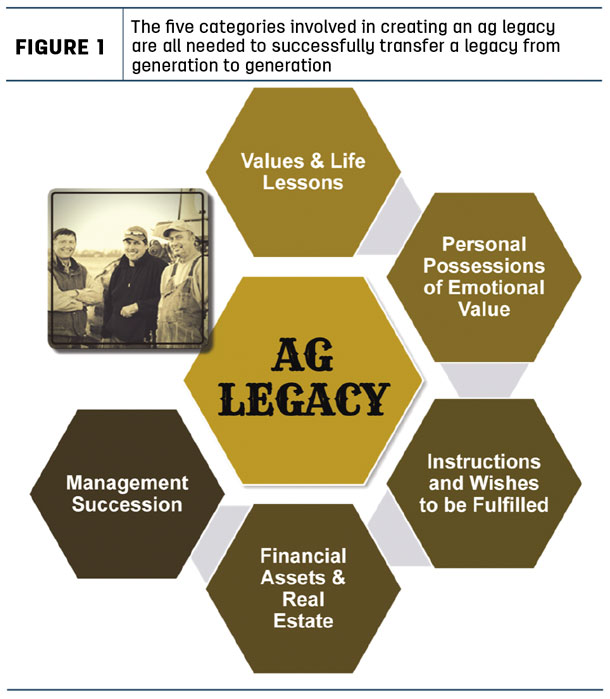Ag legacy is the summation of a lifetime of achievement and the context in which that lifetime will be remembered. A legacy is not just money but a reputation, what was accomplished and the difference a person makes in the world as they pass through – their mark on the universe.
More importantly, a legacy is something passed along years after a person leaves the world as we know it. In historical terms, a legacy is something handed down from one generation to the next. Deciding to leave a legacy can provide a road map for the future, embracing the meaning of a life.
Why worry about a legacy? Recent studies on people’s beliefs and attitudes about legacy found that there are significant gaps in what children and their parents expect from and define as inheritance. Non-financial items parents leave behind – like ethics, morals, faith and religious beliefs – are 10 times more important to both baby boomers and their parents than the financial aspects of inheritance.
Legacy also embraces management succession – passing management of the farm or ranch on to the next generation. Rural families very often plan to pass their business on to the next generation. However, only one-third of all family businesses successfully transition management to the next generation, 70% do not survive to the second, and fully 90% do not survive to the third generation.
Legacy components
Planning an ag legacy should include discussion of all five components of a true legacy: values and life lessons, personal possessions of emotional value, fulfilling final wishes and instructions, ownership of financial assets and real estate, and management succession. If the discussions between generations do not cover all five components of a legacy, the legacy transfer will not be completed successfully.
Establishing a legacy requires open, honest relationships and communication between generations. Establishing and maintaining healthy relationships between family members is challenging at any stage in life. It is important the generations work together to make relationships satisfying rather than strained.
Developing a legacy may also require resolving conflict. All individuals experience interpersonal conflict at some point in their lives. It is not a matter of if but a matter of when. Put two or more people together for more than 10 minutes, and there is a risk of interpersonal conflict. Conflict is a natural part of life brought on by our different beliefs, experiences and values. If not managed carefully, however, conflict can harm relationships. A Lasting Legacy course 1 presents seven steps adults can use to resolve conflicts.

Forgiveness is an act of the imagination. It dares to imagine a future based on the possibility that a given hurt will not be the final word on the matter. It challenges one to give up their destructive thoughts and to believe in the possibility of a better future. To forgive another simply means no longer allowing another person’s actions or words to cause resentment, anger and pain. Forgiveness does not mean someone must reconcile with another who has treated them badly. Forgiveness is the experience of finding peace inside which can neither be compelled nor prevented by another. Forgiveness of another person may be a necessary part of establishing a truly lasting legacy.
Values and life lessons
Values and life lessons include family traditions as well as practices and beliefs that create positive feelings and are repeated at regular intervals. Oftentimes, these traditions are handed down from generation to generation. Some could be based on religious beliefs, while others could be based on culture. Each family creates their own traditions and cultivates connections between each member of the family and generations to come.
Personal possessions of emotional value
Personal possessions of emotional value are critical to consider in creating a legacy. While most people are aware of the importance of planning for the transfer of titled property, most families do not plan for the transfer of non-titled property. Transferring non-titled property can often create conflict among family members. These items may have sentimental value based on the memories and feelings they evoke. Measuring sentimental or emotional value is difficult and complicates the transfer process. This portion of the course examines the concepts of fair versus equal. It also helps a person explore what is important in such transfers, ranging from maintaining relationships to keeping privacy to giving something back to a nurturing community. Finally, it examines various methods for completing the transfer, including formal transfers, sales and donations.
Final instructions and wishes to be fulfilled
Final instructions and wishes to be fulfilled can be extremely detailed or very general. The first step is to decide what constitutes a “good” death. The second step is to identify and document wishes for the end of life: where to live, where to die, what level of medical care is desired and who should care for dependents. The third step is to document final wishes – those things pertaining to burial and memorial. In today’s world, step four, which is to provide a list of secured places and passwords, is also extremely important.
Financial assets and real estate
The fourth component of a legacy, financial assets and real estate, is the component which receives most attention when individuals consider end-of-life issues. It covers the topics of estate planning, financial planning and titled property transfer. An estate plan is a plan for the disposition of property upon a person’s death. A solid estate plan can help one enjoy financial security during retirement and provide for heirs. Estate plans impact personal finances and have legal and tax ramifications. It is important to seek appropriate counsel from an attorney, tax preparer and other professionals knowledgeable about estate planning. In the process of developing an estate plan, one must establish some basic objectives. It is important to consult with family members and obtain professional advice on how to best achieve those objectives while honoring one’s own wishes and meeting family needs.
Management succession
The fifth component of a legacy is management succession. Most founders plan to transition management responsibilities to the next generation. They often do not know where to begin and what steps to follow once they have made a start. The process begins with discovering where the family is in the transition process. Next, the family and business managers must work to understand which barriers to change are holding back the process: interpersonal issues, business issues or succession planning issues. Those barriers can arise from differences in perspectives held by each generation involved. Those differences must be addressed before effective steps can be taken to move the process of transferring management responsibilities forward.
Whether a person or a family plans to or not, they will leave a legacy of one sort or another. By talking with family and friends about life and final wishes, one can help to ensure they are remembered in the best possible light. ![]()
Ag legacy resources and online learning modules are constructed from resource materials intended to assist farm and ranch families develop a complete legacy. These include helpful worksheets, planning guides, electronic tools, references, and a host of other information assembled to provide the tools for a successful legacy. More information about establishing your ag legacy is available at Ag Legacy. Requests for additional information may be emailed.
Jay Parsons is with the University of Nebraska – Lincoln. Jeffrey Tranel is with Colorado State University.

-
John P. Hewlett
- Farm and Ranch Management Specialist
- University of Wyoming










